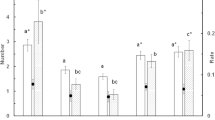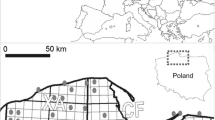Summary
In October 1984 foraging areas and foraging behaviour of the rufous horseshoe bat, Rhinolophus rouxi, were studied around a nursery colony on the hill slopes of Sri Lanka. The bats only foraged in dense forest and were not found in open woodlands (Fig. 1). This strongly supports the hypothesis that detection of fluttering prey is by pure tone echolocation within or close to echo-cluttering foliage. During a first activity period after sunset for about 30–60 min, the bats mainly caught insects on the wing. This was followed by a period of inactivity for another 60–120 min. Thereafter the bats resumed foraging throughout the night. They mainly alighted on specific twigs and foraged in flycatcher style. Individual bats maintained individual foraging areas of about 20x20 m. They stayed in this area throughout the night and returned to the same area on subsequent nights. Within this area the bats generally alighted on twigs at the same spots. Foraging areas were not defended against intruders. The bats echolocated throughout the night at an average repetition rate of 9.6±1.4 sounds/s. While hanging on twigs they scanned the surrounding area for flying prey by turning their bodies continuously around their legs. On average they performed one brief catching flight every 2 min and immediately returned to one of their favourite vantage points. Echolocation sounds may consist of up to three parts, a brief initial frequency-modulated (FM) component, a long constant frequency (CF) part lasting for about 40–50 ms, and a final FM part again (Fig. 4b, c). Adult males and females emitted pure tone frequencies in separate bands, the males from 73.5–77 kHz and the females from 76.5–79 kHz (Fig. 5). During scanning for prey from vantage points, the bats mostly emitted pure tones without any FM component (Fig. 4a). The last few pure tones emitted before take-off were prolonged to about 60 ms duration. The final FM part was therefore not an obligatory component of the echolocation signals in horseshoe bats. During flight and especially during emergence from the cave, most sounds consisted of a pure tone and loud initial and final FM sweeps. We therefore suggest that the initial FM part might also be relevant for echolocation. From our observations we conclude that the FM components are especially important during obstacle avoidance. In most sounds emitted in the field a fainter first harmonic was present. It was usually up to 30 dB fainter than the second harmonic, but in some instances it was as loud or even distinctly louder than the second one (Fig. 6a). Even within one sound the intensity relationship between the two harmonics may be reversed. We therefore suggest that the first harmonic is an integral part of the signal and relevant for information analysis in echolocation.
Similar content being viewed by others
References
Bell GP (1982) Behavioral and ecological aspects of gleaning by the desert insectivorous bat, Antrozous pallidus. Behav Ecol Sociobiol 10:217–223
Bell GP, Fenton MB (1984) The use of Doppler-shifted echoes as a flutter detection and clutter rejection system: the echolocation and feeding behavior of Hipposideros ruber. Behav Ecol Sociobiol 15:109–114
Brown PL, Berry RD (1983) Echolocation behavior in a “flycatcher” bat, Hipposideros diadema. Acoust Soc Am (Suppl 1) 74:532
Bruns V (1976) Peripheral auditory tuning for fine frequency analysis of the CF-FM bat, Rhinolophus ferrumequinum. II.-Frequency mapping in the cochlea. J Comp Physiol 106:87–97
Feng AS, Vater M (1985) Functional organization of the cochlear nucleus of rufous horseshoe bats (Rhinolophus rouxi): frequencies and internal connections are arranged in slabs. J Comp Neurol 235:529–553
Fiedler J (1979) Prey catching with and without echolocation in the Indian false vampire (Megaderma lyra). Behav Ecol Sociobiol 6:155–160
Glaser W (1974) Zur Hypotheses des Optimalempfangs bei der Fledermausortung. J Comp Physiol 94:227–248
Griffin DR, Simmons JA (1974) Echolocation of insects by horseshoe bats. Nature 205:731–732
Guppy A, Coles R (to be published) Acoustical and neural aspects of hearing in the Australian gleaning bats, Macroderma gigas and Nyctophylus gouldi. J Comp Physiol
Habersetzer J (1982) Untersuchungen zur Echoortung und zur Ökologie der Fledermäuse in Madurai. Diss. FB Biologie Universität Frankfurt/Main
Habersetzer J, Schuller G, Neuweiler G (1984) Foraging behavior and Doppler shift compensation in echolocating hipposiderid bats, Hipposideros bicolor and Hipposideros speoris. J Comp Physiol 155:559–567
Link A, marimuthu G, Neuweiler G (to be published) Echolocating Hipposiderid and Rhinolophid bats only react to moving prey. J Comp Physiol
Miller LA, Andersen BB (1984) Studying bat echolocation signals using ultrasonic detectors. Z Säugetierkd 49:6–13
Neuweiler G (1976) Die Echoortung der Fledermäuse. Rhein Westf Akad Wiss N 272:57–82
Neuweiler G (1984) Foraging, echolocation and audition in bats. Nature 71:446–455
Neuweiler G, Möhres FP (1967) Die Rolle des Ortsgedächtnisses bei der Großblatt-Fledermaus Megaderma lyra. Z Vergl Physiol 57:147–171
Neuweiler G, Bruns V, Schuller G (1980) Ears adapted for detection of motion, or how echolocating bats have exploited the capacities of the mammalian auditory system. J Acoust Soc Am 68:741–753
O'Neill WE, Suga N (1982) Encoding of target range and its representation in the auditory cortex of the mustached bat. J Neurosci 2:17–31
O'Neill WE, Schuller G, Radtke-Schuller S (1985) Functional and anatomical similarities in the auditory cortices of the Old World horseshoe bat and neotropical mustached bat for processing of similar biosonar signals. Assoc Res Otolaryngol Midwinter Meet Clearwater (Abstract)
Phillips WWA (1980) Manual of the mammals of Sri Lanka. Wildlife and Nature Protection Society Sri Lanka, Colombo
Roberts LH (1972) Variable resonance in constant frequency bats. J Zool Lond 166:337–348
Rübsamen R, Eckrich M, Costa HH (to be published) Cave dwelling bats in Sri Lanka. Spol Zeylonica
Schnitzler HU (1968) Die Ultraschall-Ortungslaute der Hufeisen-Fledermäuse in verschiedenen Ortungssituationen. Z Vergl Physiol 57:376–408
Schnitzler HU (1978) Die Detektion von Bewegungen durch Echoortung bei Fledermäusen. Verh Dtsch Zool Ges 71:16–33
Schnitzler HU, Menne D, Kober R, Heblich K (1983) The acoustical image of fluttering insects in echolocating bats. In: Huber F, Markl H (eds) Neuroethology and behavioral physiology. Springer, Berlin Heidelberg New York, pp 235–250
Schnitzler HU, Hackbarth H, Heilmann U, Herbert H (1985) Echolocation behavior of rufous horseshoe bats hunting for insects in flycatcher-style. J Comp Physiol 157:39–46
Schuller G (1979) Coding of small sinusoidal frequency and amplitude modulations in the inferior colliculus of the CF-FM bat, Rhinolophus ferrumequinum. Exp Brain Res 34:117–132
Schuller G (1984) Natural ultrasonic echoes from wing beating insects are encoded by collicular neurons in the CF-FM bat, Rhinolophus ferrumequinum. J Comp Physiol 155:121–128
Schuller G, Pollak GD (1979) Disproportionate frequency representation in the inferior colliculus of horseshoe bats: evidence for an acoustic fovea. J Comp Physiol 132:47–54
Shortridge GC (1934) The mammals of south-west Africa, 2 vols. Heinemann, London
Southern HN (1964) Handbook of British mammals. Blackwell, Oxford
Vater M (1982) Single unit responses in cochlear nucleus of horseshoe bats to sinusoidal frequency and amplitude modulated signals. J Comp Physiol 149:369–388
Vater M, Feng AS, Betz M (1985) An HRP-study of the frequency-place map of the horseshoe bat cochlea: morphological correlates of the sharp tuning to a narrow frequency band. J Comp Physiol 157:671–686
Vaughan TA (1976) Nocturnal behavior of the African false vampire bat (Cardioderma cor). J Mammal 57:227–248
Vaughan TA (1977) Foraging behaviour of the giant leaf-nosed bat (Hipposideros commersoni). East Afr Wildl J 15:237–249
Vaughan TA, Vaughan RP (1986) Seasonality and the behavior of the African yellow-winge bat. J Mammal 67:91–102
Vogler B, Neuweiler G (1983) Echolocation in the noctule (Nyctalus noctula) and horseshoe bat (Rhinolophus ferrumequinum). J Comp Physiol 152:421–432
Author information
Authors and Affiliations
Rights and permissions
About this article
Cite this article
Neuweiler, G., Metzner, W., Heilmann, U. et al. Foraging behaviour and echolocation in the rufous horseshoe bat (Rhinolophus rouxi) of Sri Lanka. Behav Ecol Sociobiol 20, 53–67 (1987). https://doi.org/10.1007/BF00292166
Received:
Accepted:
Issue Date:
DOI: https://doi.org/10.1007/BF00292166




